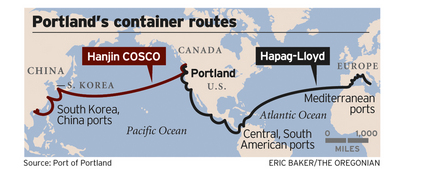forum
library
tutorial
contact

Container Shortage Threatens
Portland, Northwest Export Boom
by Richard ReadThe Oregonian, January 7, 2010
|
the film forum library tutorial contact |

|
Container Shortage Threatens
by Richard Read |
 Recession-weary Northwest farmers are landing big sales in Asia, an encouraging sign of recovery. But a severe shortage of shipping containers, as steamship lines boost rates, downsize vessels and slow ships to save fuel, stifles what could be a U.S. export boom.
Recession-weary Northwest farmers are landing big sales in Asia, an encouraging sign of recovery. But a severe shortage of shipping containers, as steamship lines boost rates, downsize vessels and slow ships to save fuel, stifles what could be a U.S. export boom.
Portland commodities trader Larry Jansky recently received 19 containers a month late. He barged the steel boxes to Idaho. He loaded them with dried peas and garbanzo beans. He got them back to Portland in time for shipping to India, Taiwan and South Korea.
Yet the vessel was full. Longshoremen left the $400,000 worth of cargo on the dock, awaiting a ship about a week later. The delay exposed Jansky's North Pacific Group Inc. to postponed payments, rising shipping rates and the risk that buyers in India, where local chickpeas ripen soon, could use the excuse to reject delivery.
"We're getting bombed with rate increases, container shortages and space issues," said Jansky, who has traded and exported for 30 years. "It's one of the most difficult times I've seen in my whole trading career."
Giant ocean carriers have lost billions during the recession. They are anchoring newly built big ships, subbing smaller ones in Portland and elsewhere, charging hundreds of dollars more per container and constricting deliveries of empties in a desperate and coordinated attempt to boost income.
The effect amounts to a sneaker wave emanating from a recession that has technically ended. It hits business especially hard in smaller, more expensive ports such as Portland, 100 miles upriver from the ocean.
"It's squelching the advantage we could have from the fact that the dollar's going down," making U.S. products cheaper abroad, said Patti Iverson-Summer, president of Global Trading Resources Inc., a Portland freight forwarder.
At the Port of Portland, managers remain confident the crisis won't cause remaining steamship lines to pull out. The Port's container service has dwindled to one transPacific route and one Europe-South America-Mediterranean circuit.
The deployment of smaller ships by carriers Hanjin and Hapag-Lloyd, which run these routes, is paradoxical just as dredgers complete a five-year project to deepen the Columbia River shipping channel. The $186 million project, to be completed by year's end, will add 3 feet to the 40-foot-deep valley carved in the river floor, accommodating larger ships and heavier loads.
The U.S. container shortage results from reduced imports. As Americans buy less Asian-made goods, fewer containers unload in the United States for use on return routes.
But hard-pressed steamship lines exacerbate the crisis, freight forwarders say. Even when a container winds up empty in a big hub such as the Port of Long Beach, ocean carriers are reluctant to spend money sending it to Portland.
"They probably could have shipped a lot more hazelnuts earlier than they did this year, but for the availability of containers," said Brenda Barnes, customer-services director for Allports, a Portland freight forwarder.
Steamship companies have parked many of the larger ships they had expected, during prosperous times, to deploy worldwide. The "ghost fleet" exceeds 580 idle container vessels anchored off Singapore and other ports.
Hanjin, the South Korean line whose vessels call on Portland, has parked ships capable of carrying a total of more than 50,000 40-foot containers, according to shipping newsletter Alphaliner. Hanjin lost $338 million in the third quarter ended Sept. 30.
In February, Hanjin will begin sending ships to Portland capable of carrying 2,000 40-foot containers, down from vessels holding more than 2,750. Freight forwarders say Hapag-Lloyd will also downsize.
Rates soar as container demand grows and supply diminishes. Six months ago Jansky paid $1000 to ship a 20-foot container to Taiwan. Now it costs about $1,650.
On Thursday, yet another rate-increase bulletin flashed on Jansky's computer screen. "Good afternoon," wrote one of his freight forwarders. "Effective immediately, Orient Overseas Container Line will revise the new rates applicable on agri for cargo-receipt date January 15th - March 2010."
"This came as a shock to us," the freight forwarder wrote, "and also to the carrier themselves." Jansky chuckled. "Yeah, right," he said. "The carrier is the one who made it."
Jansky had already booked containers at the old rates, for loading in Nebraska. "By the time they get here, the new rates will apply," Jansky said. He may have to eat the difference.
Freight forwarders are bracing for $800 rate hikes per 40-foot container in spring, although Greg Borossay, Port of Portland senior manager for trade and liner development, doubts shipping lines will get all they ask. In another negotiation affecting Portland costs, ocean carriers are in talks with the Columbia River pilots who steer vessels along the channel.
Borossay foresees better times. Portland export goods are gradually moving up-market, switching from scrap paper, for example, to more valuable cargo such as frozen fruit or vegetables. Ocean carriers charge higher rates for more expensive freight, giving them more incentive to bring empty containers here.
Once the river channel is deepened, the Port aims to attract more steamship lines.
"Portland is never going to be a mega port for containers," Borossay said. "But we think there could be successful operations for probably two transPacific and two niche players."
learn more on topics covered in the film
see the video
read the script
learn the songs
discussion forum
